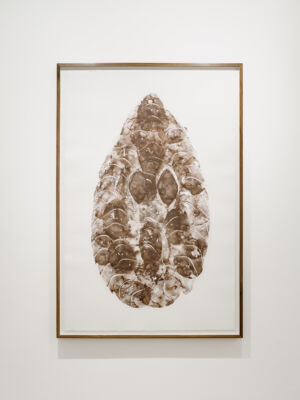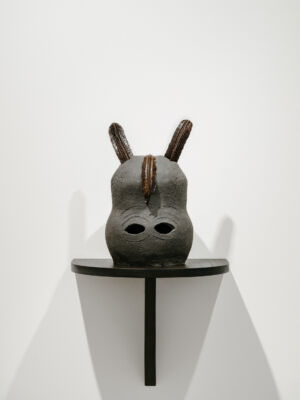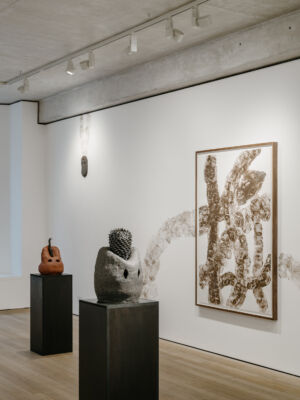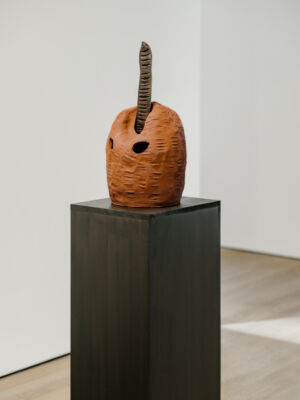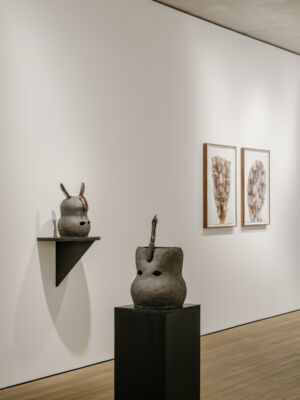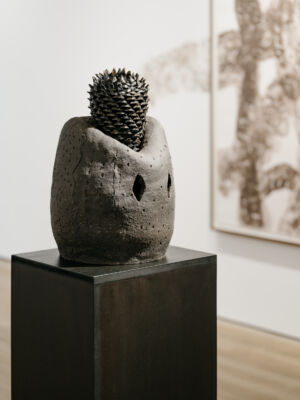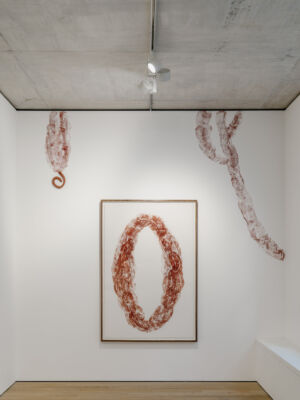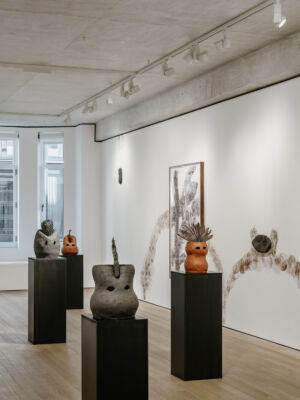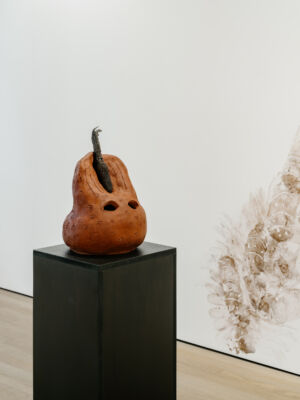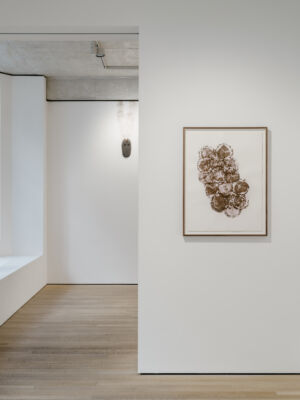Lucia Pizzani
‘Clay, seeds and other ancestors’
Curated by Jenn Ellis
Presented by Frieze Studios x Apsara Studio
March 21th – April 5th, 2025. No9 Cork Street. Gallery 2. Tuesday-Saturday, 10am-6pm. W1S 3LL, London, UK
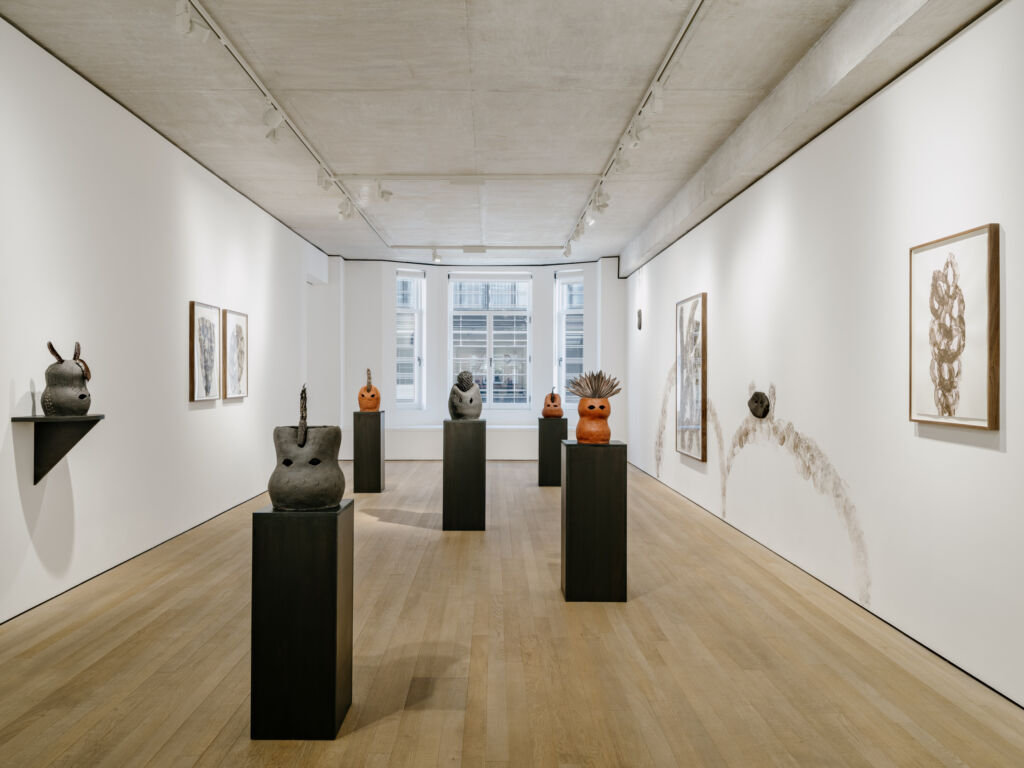
Lucia Pizzani, installation view ‘Clay, seeds and other ancestors’, 2025. Frieze Studios x Apsara Studio. No 9 Cork Street, London. Images by James Retief
‘Clay, seeds and other ancestors‘, presents Lucia Pizzani’s expressive practice that explores migration, language and materiality through the voices of plants and ancient practices. Through her use of clay and seeds, across sculpture, works on paper, performance and video, Pizzani weaves together narratives and contemplations from different temporalities around human and botanical legacies. Seeking to preserve stories of migration, from cultural traditions to the movement of plants and its implications, Pizzani speaks to her own journey from Venezuela to London, and evokes the layers and stories of an increasingly hybrid, complex and global world.
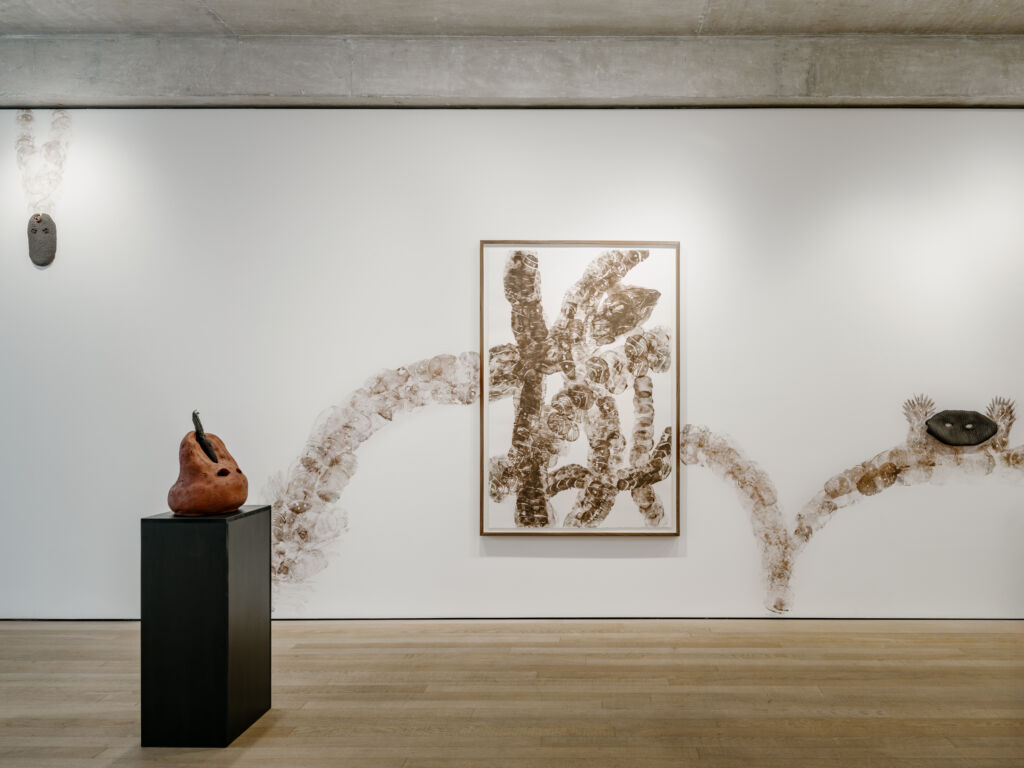
Lucia Pizzani, installation view ‘Clay, seeds and other ancestors’, 2025. Frieze Studios x Apsara Studio. No 9 Cork Street, London. Images by James Retief
Presented by Frieze Studios x Apsara Studio and curated by Colombian-Swiss curator Jenn Ellis, the exhibition premieres a newly commissioned reformulation of Pizzani’s ceramic talismans and guardians. Handmade of dark black and red stoneware clay, and raised on bespoke plinths and shelving, each sculpture incorporates imprints made by various seeds. Crucially, each holds an element of plant life, such as corn and a palm, which has been cast – for the first time – in bronze. Symbolic in its selection, the flora speak to an important cross-oceanic and cross-continental journey of ancestral significance: corn, for example, was native to the Americas, and considered by the indigenous population of Mesoamerica a gift from the gods and source of life – now, it is one of the most widely grown crops. These works are accompanied by several small to large drawings made by pressing wet clay onto paper, set amongst and within clay mark makings, that Pizzani has created directly onto the walls. This process of markmaking uses the clay’s pigment which is a testament of a territory as each one has a particular coloration. With this body of work Pizzani unfolds a story around materiality and the origin of language by using shapes and forms rooted in our collective unconscious.
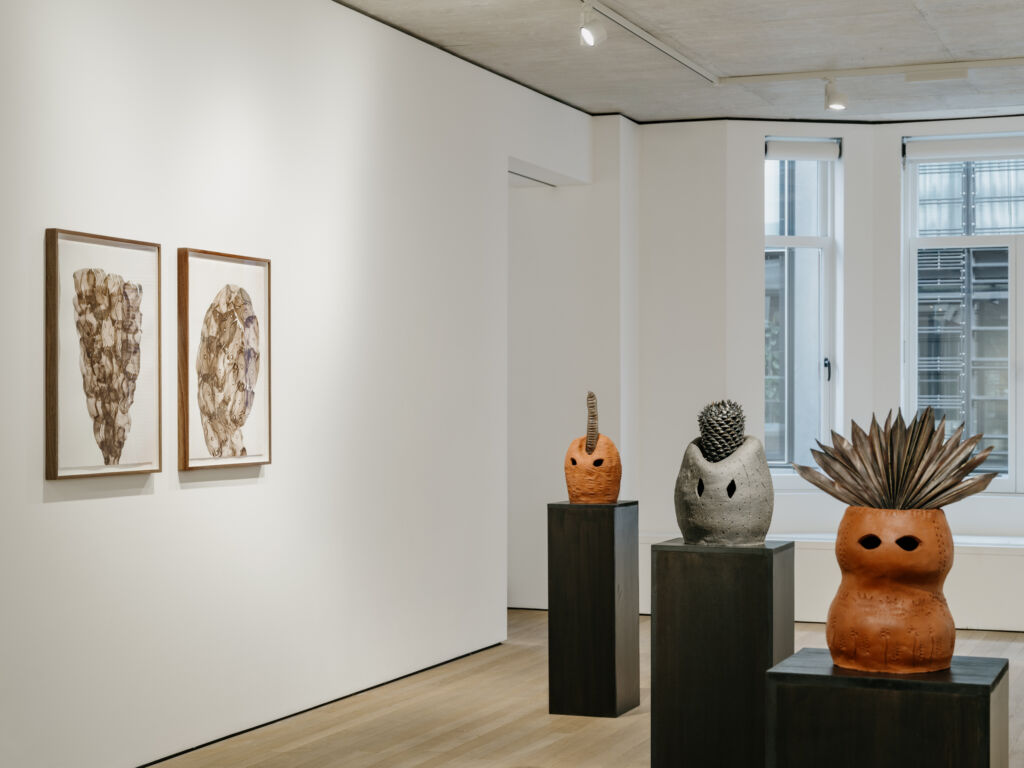
Lucia Pizzani, installation view ‘Clay, seeds and other ancestors’, 2025. Frieze Studios x Apsara Studio. No 9 Cork Street, London. Images by James Retief
Ultimately, ‘Clay, seeds and other ancestors’ is an exploration of what gets passed on and what remains. Vested in a care for our natural and human world. Pizzani’s practice considers the possibility of these two worlds as a unity of interconnections, and learning processes, and as a result: a more balanced future.
In conversation with Lucia Pizzani
“Humans and plants have migrated together and ecosystems have been historically in a permanent state of change, and even more if we think on the scale of deep time.”
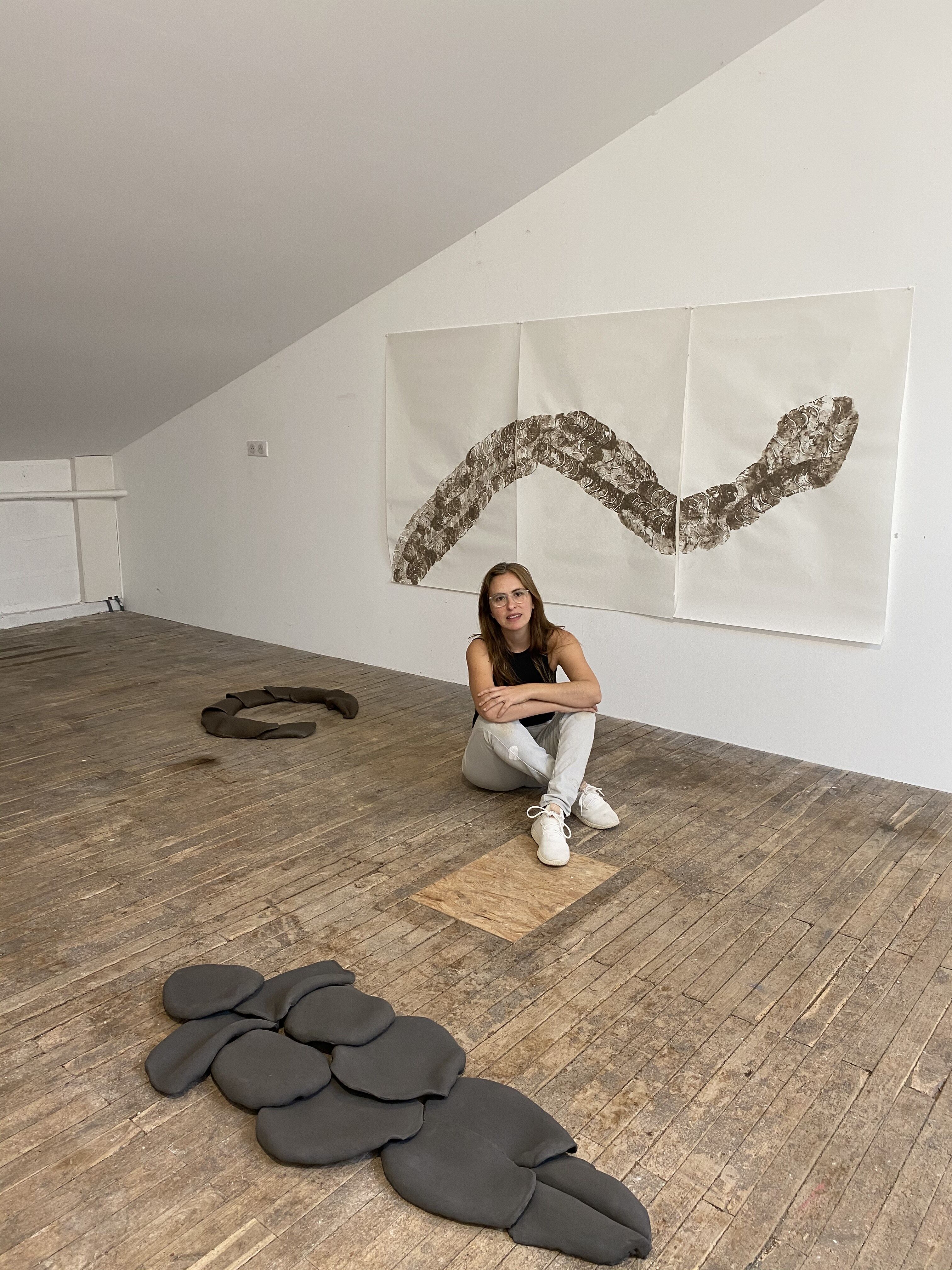
Lucia, we’re really excited to present ‘Clay, seeds and other Ancestors’ at No9 Cork Street. Tell us about the works on view, and what’s the new twist in this showcase?
This project brings a new material to my practice, the use of bronze. Continuing an investigation around ancestrality through organic elements, viewing the human as an integral part of nature, the sculptures in clay now have bronze pieces that transform vegetal fragments, almost like freezing them in time.
It also brought to mind the fact that both clay and bronze are markers in history. Pottery has been with us since the beginning for utilitarian uses and then served as a receiver for material culture, and many years later bronze became a way of making, bringing an end to the Stone Age.
This new communion of clay and bronze will be in view at ‘Clay, seeds and other ancestors’ accompanied by the Clay Drawings on paper, which are also drawn from prehistoric research. When doing a residency at Launchpad Lab in France some years ago I started developing these works on paper. The pigment of the soil used in the clay leaves the coloration and traces on the white subtract. This trace making, that I had done a decade ago, with my body in a wet plastered room for “vessel” my degree show at Chelsea College of Arts, has stayed with me. By imprinting corn on clay, by drawing in the clay and making marks that then are transferred to the paper, these imprints become two dimensional. They give testimony of a specific territory and use ancient forms and shapes.
Your work runs through fragmentary ideas of biology and botany in relation to different entities or totems you have created and named ‘Ser de Maiz,’ ‘Ser de Palma,’ ‘Ser de Tabachin’… It seems that the layers of cultural memory are also revealing your own history of migration. We’re curious to know how these have mobilised the creation of these series.
The Seres Vegetales series started out of the concern to bring the plant kingdom closer to us. As observation times are usually very long to see growth and change, I began to give anthropomorphic traits to my sculptures and works on paper. I wanted to represent the spirit of plants. It first happened while I was at Casa Wabi working on an installation for the Jardín Botánico of Puerto Escondido in Oaxaca, Mexico. When I learned about each species I was using in this group of “Seres Vegetales”, inevitably there were introduced trees that were not native. But there is a sense of ownership in many of these, the Mango for example feels that it belongs to Caracas, the tropical weather made them feel at home and the fruits are all over the place on the floor of streets, gardens and plazas. Colonial trade made trees find new homes and adapt to new lands with a similar latitude. Humans and plants have migrated together and ecosystems have been historically in a permanent state of change, and even more if we think on the scale of deep time.
Last fall, you published a beautiful monograph encompassing 15 years of work. In it, you also evidence the evolution of your work across various mediums, from photography to ceramics and organic elements. Tell us how has experimenting with these materials has shaped your artistic narrative?
Yes, my work has always been informed by materiality, even when doing photography in my early days, those images were printed on aluminium, matte canvas shaped as circles, collodion wet plates that are very much an object and other alternative process photography where material, time and light combine.
It was a natural step in my development to try ceramics, this happened more than 15 years ago and it’s a medium that for me has endless possibilities. One idea or research informs the next, as I started imprinting corn in the clay and then on paper using photosensitive inks, some of the vegetal fragments became part of a ceramic sculpture and in my latest exhibition (Morada Vegetal at Abra in Caracas) it is the dry palm resting on a bed of tree shavings that constitute a completely organic sculpture, an ephemeral one, with a lifetime like us with a beginning and an end.
The curator of the show, Jenn Ellis, describes this body of work as an exploration of what gets passed on and what endures. What are those elements, and how do you use them to connect the different disciplinary fields in your practice?
I think ideas endure, thoughts that can be expressed in a text such as this, our interview, or in books or in artworks. Then there is the story of materials that carry meaning and layers of culture, geography and time.
I always start a project with an open mind, the exploration, the unclear path that will bring doubt. I need to allow it to live as long as needed, until a medium feels the right one to express, to communicate. Residencies and time in the studio are places to allow experimentation, but also there is a feeling of vulnerability that accompanies me and that I think it’s important to keep and appreciate. Not to be fearful of failure or weirdness, performance is a perfect example for this. I push through and I will meet you on the other side, not knowing what awaits.
Thank you so much, Lucia!
Born in Caracas and based in London, Lucia Pizzani’s expressive practice involves the body and self always informed by materiality. One of her core concerns is the interrelationship between narratives of women in history and processes of metamorphosis in the natural world. She works across a variety of media – including photography, ceramics, videos, drawings, performances and installations. Having worked as part of the environmental movement in Venezuela for many years, she has always incorporated ecological elements into her artwork.
Her work is part of the TATE Collection, Magasin III Museum for Contemporary Art (Stockholm), Essex Collection for Art from Latin America ESCALA and the Colección Patricia Phelps de Cisneros (CPPC) amongst others. Recent exhibitions, residencies and commissions include SMOKE (curated section, Frieze London 2024), El Cercado Ceramic school (Isla de Margarita, Venezuela), the Harewood Biennial (Leeds, UK), Planet B Climate Change and the new sublime, curated by Nicolas Bourriaud at Palazzo Bolanni (Venice), Peckham24 (London), Casino Luxembourg (Luxemburg), TEA Museum (Tenerife), Casa Wabi and the Puerto Escondido Botanical Garden (Oaxaca, Mexico), LaunchPad Lab (Charente, France) and Hacienda La Trinidad Art Centre (Caracas). She is a studio artist at Gasworks (London).
